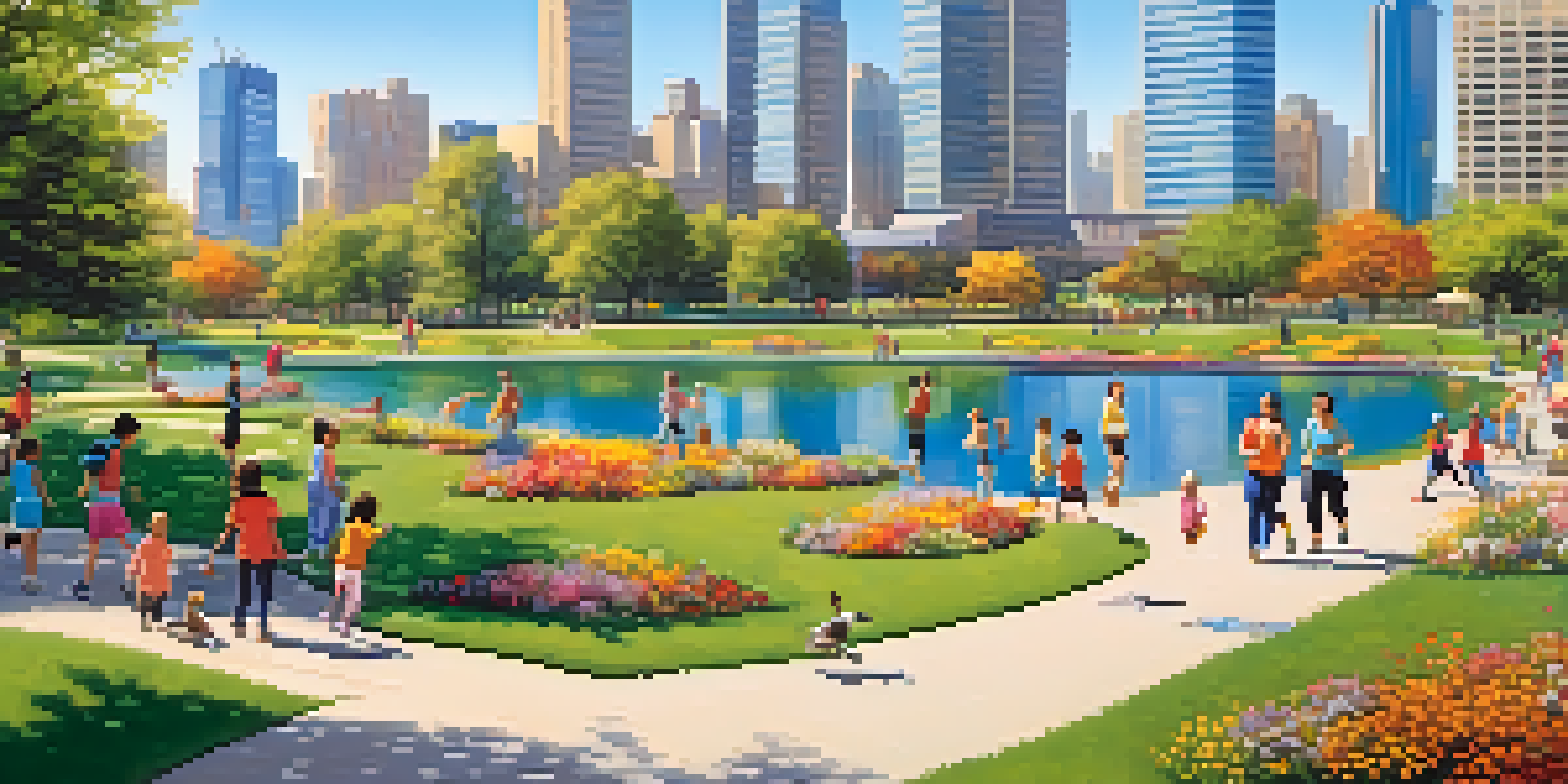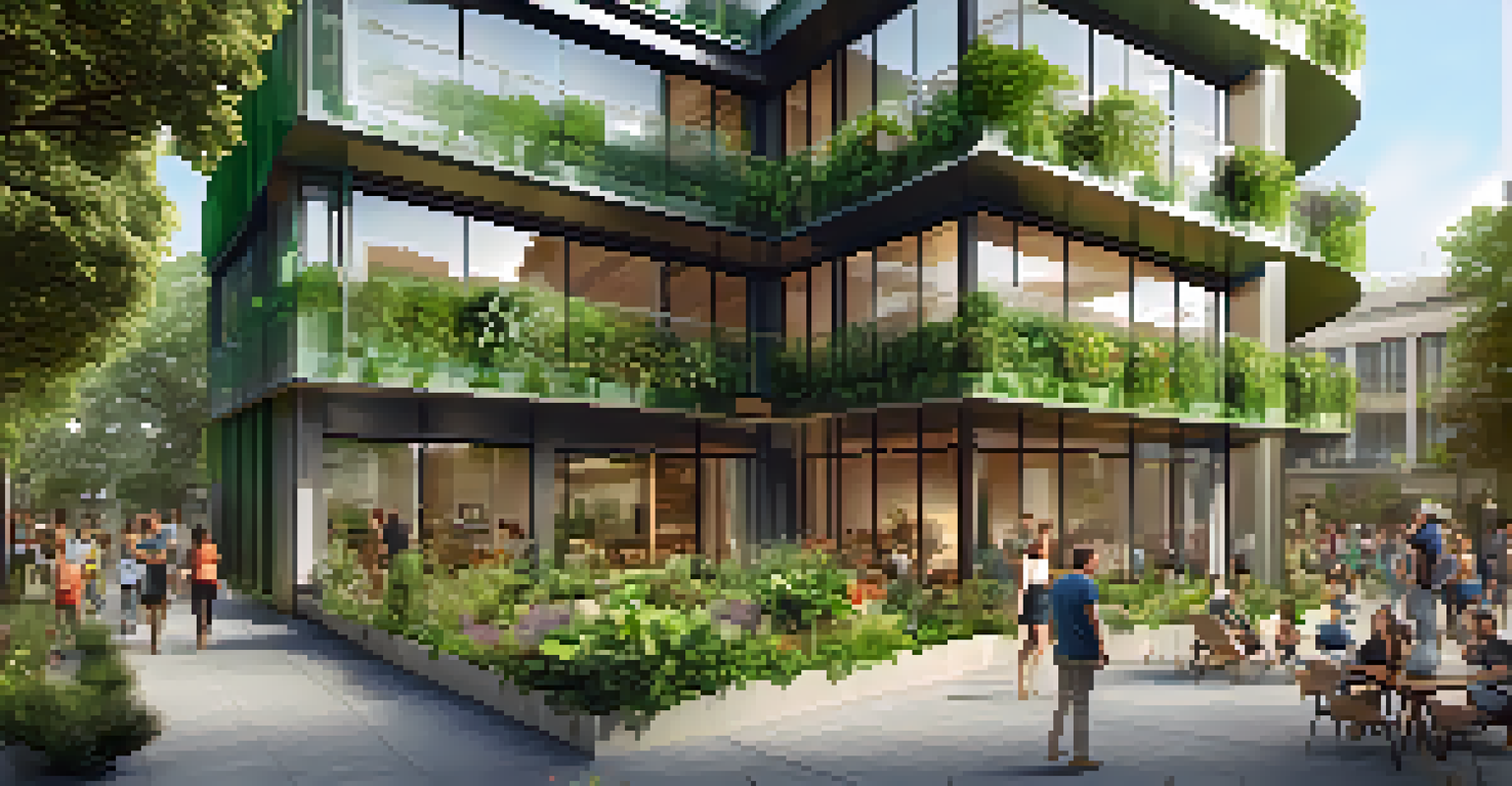Sustainable Urban Living: A Future Perspective

Understanding Sustainable Urban Living and Its Importance
Sustainable urban living refers to creating cities that prioritize environmental health, social equity, and economic viability. This approach aims to reduce the ecological footprint of urban areas while enhancing the quality of life for residents. As urban populations continue to grow, the need for sustainable practices becomes increasingly crucial.
The greatest threat to our planet is the belief that someone else will save it.
Imagine a city where green spaces are abundant, public transport is efficient, and waste is minimized. This vision not only promotes a healthier environment but also fosters community engagement and social connections. By embracing sustainability, cities can become vibrant hubs that cater to the needs of all their inhabitants.
Moreover, sustainable urban living helps mitigate climate change impacts, such as flooding and heatwaves, by incorporating green infrastructure. Cities that invest in sustainability are not only preparing for future challenges but also setting a precedent for responsible living. This holistic approach is essential for nurturing both people and the planet.
The Role of Green Architecture in Urban Sustainability
Green architecture involves designing buildings that are energy-efficient, environmentally friendly, and resource-conscious. This concept not only focuses on the aesthetics of a structure but also its ecological impact throughout its lifecycle. The integration of sustainable materials and technologies can significantly reduce a building's carbon footprint.

For instance, consider a residential building equipped with solar panels and rainwater harvesting systems. Such features not only lower energy costs for residents but also contribute to the city’s overall sustainability goals. By utilizing natural light and ventilation, green architecture can create healthier living environments that enhance well-being.
Sustainable Cities Enhance Life Quality
Sustainable urban living prioritizes environmental health, social equity, and economic viability, improving the quality of life for all residents.
Additionally, green buildings often encourage community interaction through shared spaces and gardens. This fosters a sense of belonging and promotes social sustainability. As cities evolve, prioritizing green architecture will be key to developing urban spaces that are both functional and environmentally responsible.
Public Transportation: The Backbone of Sustainable Cities
Efficient public transportation systems play a pivotal role in promoting sustainable urban living. By providing reliable alternatives to personal vehicles, cities can reduce traffic congestion and lower greenhouse gas emissions. Comprehensive public transit networks make it easier for residents to navigate urban areas without relying on cars.
Sustainability is no longer about doing less harm. It's about doing more good.
For example, cities like Copenhagen and Tokyo have successfully integrated cycling and public transport, making commuting both convenient and eco-friendly. This not only decreases pollution but also encourages healthier lifestyles through increased physical activity. When public transportation is prioritized, it contributes to a more connected and vibrant urban community.
Moreover, investing in electrified and low-emission public transit options can further enhance sustainability efforts. As cities embrace smart technologies, real-time tracking and mobile apps can improve the overall user experience. A robust public transportation system is essential for fostering sustainable urban living and reducing dependence on fossil fuels.
Community Engagement: Building Sustainable Neighborhoods
Community engagement is a vital component of sustainable urban living, as it fosters collaboration and shared responsibility among residents. When individuals come together to address local challenges, they can create innovative solutions that benefit everyone. This collective effort is crucial for developing neighborhoods that are both resilient and sustainable.
Imagine a neighborhood where residents organize clean-up events, community gardens, and educational workshops on sustainability. These activities not only enhance the local environment but also strengthen social bonds and promote a sense of ownership. Engaged communities are more likely to advocate for sustainable policies and practices.
Green Architecture Reduces Footprint
Integrating energy-efficient and eco-friendly designs in buildings significantly lowers their carbon footprint and promotes healthier living environments.
Additionally, involving residents in the urban planning process ensures that development meets the needs of the community. By prioritizing inclusivity, cities can create spaces that reflect diverse interests and promote equity. Community engagement is the heart of sustainable urban living, driving positive change from the ground up.
Green Spaces: Essential for Urban Health and Well-Being
Green spaces, such as parks and gardens, are essential for promoting health and well-being in urban environments. They offer a refuge from the hustle and bustle of city life, providing residents with opportunities to connect with nature. Access to green spaces has been linked to improved mental health, physical activity, and overall quality of life.
Consider a park in the center of a bustling city that serves as a gathering place for families, friends, and community events. Such spaces encourage social interaction and foster a sense of belonging, contributing to a vibrant urban culture. Green spaces can also help mitigate urban heat and improve air quality, making cities more livable.
Furthermore, incorporating native plants and biodiversity into urban landscaping can enhance ecological resilience. Cities that prioritize green spaces demonstrate a commitment to sustainability and environmental stewardship. By investing in these areas, urban planners can create healthier, happier communities for all residents.
Waste Management Innovations for Sustainable Cities
Effective waste management is crucial for achieving sustainability in urban areas. Innovative practices, such as recycling, composting, and waste-to-energy technologies, can significantly reduce the amount of waste sent to landfills. By implementing comprehensive waste management systems, cities can minimize their environmental impact and promote responsible consumption.
For example, cities like San Francisco have made remarkable strides in waste diversion by implementing zero waste programs. These initiatives not only encourage residents to recycle and compost but also educate them about the importance of reducing waste at the source. Through community involvement, cities can create a culture of sustainability that inspires action.
Community Engagement Drives Change
Active community involvement in sustainability initiatives fosters collaboration and leads to innovative solutions for local challenges.
Additionally, integrating smart waste management technologies can enhance efficiency and reduce operational costs. Sensors in waste bins can alert city services when they need to be emptied, preventing overflow and optimizing collection routes. Innovations in waste management are essential for fostering sustainable urban living and ensuring a cleaner, greener future.
The Future of Urban Agriculture: Feeding Cities Sustainably
Urban agriculture is emerging as a vital solution for promoting food security and sustainability in cities. By utilizing vacant lots, rooftops, and community gardens, residents can grow their own food, reducing reliance on external sources. This practice not only enhances local food systems but also contributes to community resilience.
Picture a bustling city where fresh produce is grown right in the heart of the neighborhood. Urban farms not only provide access to healthy food options but also create green jobs and foster social connections among residents. This synergy between food production and urban living is essential for sustainable development.

Moreover, integrating technology into urban agriculture can enhance productivity and sustainability. Vertical farming and hydroponic systems allow for efficient use of space and resources, making it possible to grow food in limited areas. As cities continue to evolve, urban agriculture will play a crucial role in shaping sustainable urban living and feeding future generations.
Embracing Technology for Smart and Sustainable Cities
Technology is transforming the way we approach urban living, making cities smarter and more sustainable. From smart grids to energy-efficient buildings, innovations are helping cities optimize resources and reduce waste. Embracing technology can enhance the quality of life for residents while promoting environmental sustainability.
For instance, smart city initiatives can improve traffic management, reduce energy consumption, and enhance public safety. By leveraging data and connectivity, cities can create efficient systems that respond to the needs of their residents. This technological integration paves the way for a more sustainable urban future.
However, it's essential to ensure that technology is accessible to all residents, promoting inclusivity in urban development. Engaging communities in the implementation of smart solutions can foster a sense of ownership and encourage active participation. As we look ahead, technology will undoubtedly play a key role in shaping sustainable urban living for generations to come.